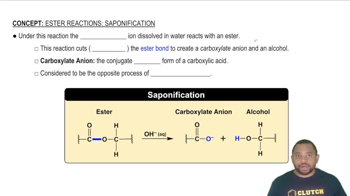Write a balanced chemical equation using condensed structural formulas for the saponification (base hydrolysis) of
a. methyl propionate
 Brown 14th Edition
Brown 14th Edition Ch.24 - The Chemistry of Life: Organic and Biological Chemistry
Ch.24 - The Chemistry of Life: Organic and Biological Chemistry Problem 52b
Problem 52b Verified step by step guidance
Verified step by step guidance



Write a balanced chemical equation using condensed structural formulas for the saponification (base hydrolysis) of
a. methyl propionate
Write a balanced chemical equation using condensed structural formulas for the saponification (base hydrolysis) of
b. phenyl acetate.
Write a balanced chemical equation using condensed structural formulas for
a. the formation of butyl propionate from the appropriate acid and alcohol
(a) Draw Lewis structures for chloromethane 1CH3Cl2, chloroethene 1C2H3Cl2, and chloroethyne 1C2HCl2. Draw Lewis structures for chloromethane 1CH3Cl2.
(a) Draw Lewis structures for chloromethane 1CH3Cl2, chloroethene 1C2H3Cl2, and chloroethyne 1C2HCl2. Draw Lewis structures for chloroethene 1C2H3Cl2.
(a) Draw Lewis structures for chloromethane 1CH3Cl2, chloroethene 1C2H3Cl2, and chloroethyne 1C2HCl2. Draw Lewis structures for chloroethyne 1C2HCl2.